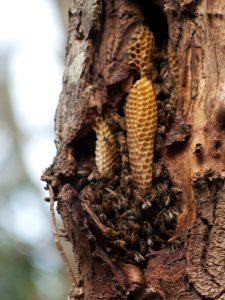Click Here if you listened. We’re trying to gauge interest so only one question is required; however, there is a spot for feedback!
Read along below!
Found in Translation
City Bee, Country Bee
By: Jay Evans, USDA Beltsville Bee Lab
In Aesop’s fable, City (Town) Mouse, Country Mouse, a city mouse regales her skeptical country cousin with a rosy view of high density living. Sampling both, the country mouse prefers to stay put, largely because “the country mouse lives in a cozy nest at the bottom of a tree. Her home is small, but it is warm and comfortable.” Plus… no cats!
Beekeepers and bee scientists like to contrast the lives of bees under our care in apiaries (dense cities of colonies) versus those out on their own in trees. Aside from giving general insights into bee biology, these comparisons can predict the risks of managed and feral bees sharing disease while also showing how well ‘city’ and ‘country’ bees deal with various stresses. We have great data for the numbers of managed colonies, but how many country bees are we talking about?
I have discussed before the achingly beautiful (and hard) work by Tom Seeley and students assessing feral bees in a U.S. forest. Borrowing from those and similar studies, we can get a rough estimate of how many country bees there are in hollow trees and other cavities. My Sunday afternoon and small brain can’t grapple with honey bee density in deserts and the vast tundra, but considering four adjoining states (New York, Pennsylvania, Maryland and Virginia) with decent land-use data from the USDA (https://www.ers.usda.gov/data-products/major-land-uses/maps-and-state-rankings-of-major-land-uses/), we can estimate ‘suitable’ acreage (fallow fields, pasture and forests) at around 58 million acres total (60% of the available land). Using consensus estimates of 2.5 colonies/square-mile (one colony/square kilometer, 0.004 colonies/acre), one arrives at 233,000 feral honey bee colonies in these four states. According to USDA (https://www.nass.usda.gov/Surveys/Guide_to_NASS_Surveys/Bee_and_Honey/) ,there were 67,500 managed colonies in these states on January 1, 2021, surveying beekeepers with five or more hives. Even doubling this number to account for backyard beekeepers and those who evade surveillance, there are still fewer managed than feral colonies in these regions.
 So, free-living bees are likely to be important for their own sake, and for the environment. What’s it like out there? Taking a disease angle, several studies have compared the relative disease loads of managed and feral colonies in the U.S. Amy Geffre and colleagues from San Diego sampled boxed and free-living colonies (three colonies each) seven times over the course of a year to measure virus levels for three common bee viruses (Preliminary analysis shows that feral and managed honey bees in Southern California have similar levels of viral pathogens. 2023. Journal of Apicultural Research, 62:3, 485-487, DOI:10.1080/00218839.2021.2001209). Both colony types were remarkably similar in virus levels, changing with the season but hardly differing from each other.
So, free-living bees are likely to be important for their own sake, and for the environment. What’s it like out there? Taking a disease angle, several studies have compared the relative disease loads of managed and feral colonies in the U.S. Amy Geffre and colleagues from San Diego sampled boxed and free-living colonies (three colonies each) seven times over the course of a year to measure virus levels for three common bee viruses (Preliminary analysis shows that feral and managed honey bees in Southern California have similar levels of viral pathogens. 2023. Journal of Apicultural Research, 62:3, 485-487, DOI:10.1080/00218839.2021.2001209). Both colony types were remarkably similar in virus levels, changing with the season but hardly differing from each other.
In Persistent effects of management history on honey bee colony virus abundances (2021. Journal of Invertebrate Pathology 179:107520, https://doi.org/10.1016/j.jip.2020.107520), Lewis Bartlett and colleagues found similar patterns between free-living and managed colonies but noted that the style of management might play a role. Namely, colonies maintained in a larger commercial apiary (hundreds of colonies) tended to have the highest levels of most viruses, with feral and low-intensity ‘backyard’ colonies being about the same. As in most field studies, there is abundant variation for viral disease within each category, so these results will need even more sampling to see how viruses and bees fare under different management styles. Nevertheless, they suggest that beekeepers adopting a ‘country bee’ approach by spacing out colonies to reduce urban interactions will be doing their bees a favor.
In the most ambitious study to date, Chauncy Hinshaw and colleagues surveyed 25 colonies each from feral and managed colonies in Pennsylvania (2021. The role of pathogen dynamics and immune gene expression in the survival of feral honey bees. Frontiers in Ecology and Evolution, 8, 594263. https://doi.org/10.1080/00218839.2021.2001209). They surveyed ample bee numbers per collection (75 worker bees), perhaps getting a better sense of average disease loads. Even better, they paired similar city and country colonies from a bunch of regions, which helps account for other factors that might change virus loads. In this study, managed colonies tended to have lower levels of mite-transmitted deformed wing virus, presumably reflecting mite treatments, and roughly similar levels of black queen cell virus and nosema. Perhaps reflecting pathogen exposure, feral colonies had higher levels of several immune response proteins as well. Given the higher number of sampled colonies, these researchers were also able to show how their measurements related to colony fates. As in prior studies, deformed wing virus, presumably alongside mite loads, was a good predictor of a bad colony outcome.
Colonies showing higher levels of two immune genes, once other factors were evened out, were more likely to survive the study period. Arguably, these proteins might be good predictors of genetic components that help bees survive in the face of disease.
More can be done to contrast the lives and successes of city and country bees. These comparisons can help improve bee management by those of us keeping bees in clusters of Langstroth high-rises. It is also fun to think of bees in the ancestral habits they have followed for thousands of years. Country bees almost certainly have more threats now than they did when humans were more scarce, and there has to be some level of contact between city bees and country bees that muddies all of these comparisons, but in many ways the presence of country bees at all is comforting. Left to their own care, they are making country homes work wherever they can, and that is a good lesson for beekeepers.
In full disclosure, the lives of country bees were not on my mind until a recent inquiry from British bee researcher Francis Ratnieks and his graduate student Ollie Visick. In their Laboratory for Apiculture and Social Insects (https://www.sussex.ac.uk/lasi/), they are comparing the lives of free-living honey bees in their native range to their hived cousins. As ecologists, their studies will give insights into how honey bees used to live in the forests and fields of England. I thank them for the prompt (and welcome hot tips from any of you) and look forward to reading their results!









